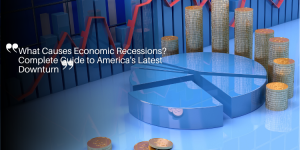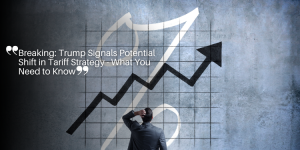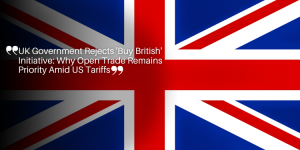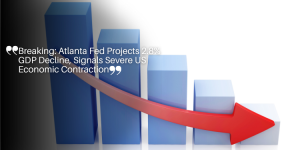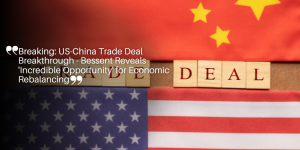Stagflation Explained: How Trade Tariffs and Economic Slowdown Could Trigger a Perfect Storm
Understanding Stagflation: A Perfect Economic Storm
Stagflation, a term coined during the economic turmoil of the 1970s, refers to the unusual and unfavorable combination of stagnant economic growth and high inflation.
Simply put, it’s when an economy is experiencing slow growth or even contraction, while prices for goods and services are rising rapidly.
This situation creates a difficult predicament for policymakers because the measures to combat inflation often further hinder economic growth and vice versa.
Stagflation vs. Regular Inflation or Recession
Typically, an economy dealing with inflation is still growing, albeit with rising prices reducing the purchasing power of consumers and businesses.
In contrast, a recession is characterized by negative economic growth, high unemployment, and typically low inflation due to decreased demand.
Stagflation uniquely blends these two undesirable traits, resulting in both a slow or contracting economy and high inflation at the same time.
Historical Context
The most notable period of stagflation in the United States occurred during the 1970s and early 1980s.
This era was marked initially by an oil embargo imposed by Saudi Arabia and other oil-producing nations, which drastically increased oil prices and contributed to a surge in the cost of living.
The US experienced high inflation and unemployment rates simultanously.
Efforts to control inflation through monetary policy, such as raising interest rates, further exacerbated economic slowdown, creating a particularly challenging economic environment that took years to fully resolve.
Understanding the historical context of stagflation offers valuable insights into how similar conditions might emerge today.
As we delve into current economic warning signs and potential root causes, we can better appreciate the complexities policymakers face when addressing such a multifaceted issue.
Current Economic Warning Signs
As we delve into the current economic landscape, several warning signs have surfaced, indicating a potential storm.
Historically, worries about stagflation – characterized by sluggish growth paired with high inflation – have been linked to significant economic turmoil.
Today, similar indicators are re-emerging.

Declining Job Growth and Market Contraction
Recent economic reports have painted a concerning picture.
A notable slowdown in job growth has been observed, with private sector employers adding just 77,000 jobs in February, the weakest performance since July.
This is a significant shortfall compared to previous months.
Adding to the bleak outlook, data suggests a contraction in economic activity; a closely-monitored figure indicates the economy is in deep contraction for the first quarter.
These indicators, collectively, reveal a hesitancy among employers and a marked dip in hiring activities as they navigate uncertain economic waters.
Impact of Trade Tariffs
Trade policies have their role to play in these developments.
The 20% tariff imposed on Chinese goods has sparked considerable debate.
While intended to mitigate costs associated with proposed tax cuts, the timing couldn’t be worse.
The tariffs coincide with an economic slowdown, amplifying cost burdens for consumers and businesses alike.
As analysts fear, this policy might lead to broader economic damage rather than just making consumer goods more expensive.
The tariffs have injected a considerable amount of uncertainty into stock markets and business environments.
For instance, consumer confidence – an essential driver of spending – has plummeted.
Comments from corporate leaders reinforce this perspective; several retailers have forecasted a sharp decline in profits, attributing this to both consumer hesitancy and tariff impacts.
This, in turn, leads to lower sales and further dampens economic activity.
Growing Uncertainty Among Consumers and Business Leaders
The broader result is a climate of cautious pessimism among both consumers and business leaders.
Investor sentiment has taken a hit, precipitated by the aforementioned uncertainties.
Yields on U.S. government bonds have dropped significantly, indicating a market bracing for tough times ahead.
Consumer confidence, critical for sustaining economic momentum, is at a low.
This sinking sentiment is compounded by corporate forecasts expecting diminished profitability due to tariffs and uncertain market conditions.
The convergence of these factors creates a gloomy economic environment, with stagnating growth feeding into inflationary pressures.
As stakeholders proceed with caution, the threat of stagflation looms larger, making strategic decision-making more complex and precarious.
These emerging signs suggest that policymakers, businesses, and consumers alike must navigate carefully to avert a fully-fledged economic crisis.
Root Causes and Triggers
Stagflation is a multifaceted economic challenge, influenced by various factors, primarily focusing on raw material costs, policy decisions, and consumer behavior.
Let’s delve into the root causes and triggers that could potentially lead to this economic condition.
Spike in Raw Material Costs
One of the primary contributors to stagflation is a sudden and significant increase in the cost of raw materials.
This scenario creates a ripple effect that impacts the overall economy.
When raw material prices surge, the cost of production for goods and services also rises.
Consequently, businesses are forced to increase prices, leading to inflation.
However, high raw material costs can also stifle economic growth by straining business budgets and reducing profit margins, ultimately leading to a slowdown in investment and expansion.
During the 1970s, for instance, Saudi Arabia and other countries imposed an oil embargo on the United States.
This led to skyrocketing oil prices, which, coupled with rising inflation, left consumers with less disposable income.
The economic impact was enduring, with inflation and unemployment levels consistently above 5% for nearly a decade.
Policy Decisions: Tariffs and Trade Restrictions
Policy decisions, such as tariffs and trade restrictions, play a crucial role in fostering stagflation.
The recent 20% tariff on Chinese goods serves as a modern example.
While intended to protect domestic industries, such tariffs can backfire by increasing costs for imported goods, thereby fueling inflation.
Added to that, the uncertainty surrounding tariffs can lead to reduced consumer confidence and cautious spending.
Businesses, facing higher import costs and unpredictable trade policies, may become hesitant to invest in growth initiatives.
As a result, economic activity slows down, which, when combined with rising prices, creates the ideal conditions for stagflation.
Consumer Spending Patterns and Business Confidence
Consumer spending patterns and business confidence are interlinked and significantly influence the economic landscape.
When consumers feel uncertain about the future, they tend to save more and spend less, leading to reduced demand for goods and services.
This decrease in spending can contribute to economic stagnation.
Simultaneously, businesses, perceiving reduced consumer demand and economic uncertainty, may cut back on hiring, investment, and expansion plans.
Such actions can further exacerbate economic stagnation by leading to higher unemployment rates and reduced overall economic activity.
The interconnectedness of reduced consumer spending and cautious business behavior creates a vicious cycle that is difficult to break.
Understanding and addressing these root causes is critical for policymakers.
Effective strategies to mitigate the risks of stagflation will need to consider the complex interplay of these factors to stabilize the economy and promote growth.
The Federal Reserve’s Dilemma
Challenging Balance: Fighting Inflation and Supporting Growth
The Federal Reserve is facing a tough balancing act.
On one hand, it needs to curb inflation, which involves tightening monetary policy through higher interest rates.
On the other hand, higher rates can stifle economic growth, making it difficult to combat sluggish economic performance.
This dual mandate of maintaining low inflation while promoting maximum employment puts the Fed in a precarious position, especially under stagflation conditions.
Potential Monetary Policy Responses
To manage stagflation, the Federal Reserve might consider several monetary policy strategies.
Raising interest rates can help control inflation, but this move risks further dampening economic growth and increasing unemployment.
Conversely, lowering rates could stimulate growth but might exacerbate inflation.
| 📌 Policy Tool | 💡 Description |
|---|---|
| 📈 Interest Rate Hikes | Raising interest rates helps control inflation by reducing borrowing and spending, but it may also slow economic growth and increase unemployment. |
| 📉 Interest Rate Cuts | Lowering interest rates stimulates economic activity by making borrowing cheaper, though it can lead to higher inflation if demand grows too fast. |
| 💵 Quantitative Easing (QE) | The Fed buys long-term securities to inject liquidity into the economy, promoting growth but risking inflation if not carefully managed. |
Managing Stagflation Risks
The Federal Reserve has limited tools to manage stagflation due to its unique challenges.
The dual crises of high inflation and economic stagnation often demand contrasting policy measures.
One potential approach might be a measured, data-driven response where the Fed adjusts rates incrementally based on economic indicators, balancing immediate needs against long-term stability.
- 💵Forward Guidance: Clear communication about future policy intentions can help manage market and consumer expectations, possibly mitigating some adverse effects.
- 💵Selective Targeting: The Fed might focus on specific economic sectors that are more controllable or less sensitive to broad rate changes, using targeted interventions to stimulate growth without triggering runaway inflation.
While these steps offer pathways to manage stagflation, the inherent tension between inflation control and growth support remains a core challenge for the Federal Reserve.
Reducing uncertainty through transparent policymaking will be crucial as the Fed navigates this complex economic landscape.
Economic Implications and Future Outlook
Impact on Businesses and Consumers
Stagflation creates a challenging environment for both businesses and consumers.
For businesses, the combination of sluggish economic growth and high inflation means rising costs and declining sales.
Companies may struggle to maintain profitability as the cost of raw materials, labor, and transportation increases, while consumer demand weakens.
Businesses may respond by cutting costs, reducing investments, and even laying off workers, which can further exacerbate the economic slowdown.
Consumers, on the other hand, face the dual burden of higher prices and reduced income.
As inflation erodes purchasing power, households may find it difficult to afford essential goods and services.
This can lead to decreased spending, which negatively impacts business revenues and, in turn, leads to more job losses and economic contraction.
The overall uncertainty can cause consumers to delay major purchases, thereby reducing the economic activity even more.
Historical Lessons
The stagflation of the 1970s offers key lessons for managing the current economic landscape.
During that period, the United States experienced a severe recession caused by a combination of an oil embargo and poor economic policy decisions.
High unemployment and soaring inflation defined this era, and it took drastic measures, including significant interest rate hikes, to stabilize the economy.
One significant takeaway is the importance of timely and decisive policy action.
Delays in addressing stagflation can prolong the economic pain and make recovery more difficult.
Moreover, managing inflation expectations is crucial.
During the 1970s, failure to control inflation expectations led to persistent high inflation, which required aggressive monetary tightening to finally bring under control.
Possible Scenarios for Economic Recovery
There are several potential pathways for economic recovery from stagflation.
A balanced approach that includes both monetary and fiscal policies could be effective.
- Monetary Policy Adjustments: The Federal Reserve might consider moderate interest rate hikes to control inflation while providing targeted support to sectors most affected by economic stagnation. This delicate balance aims to maintain consumer and business confidence while preventing further economic slowdown.
- Fiscal Stimulus: Government spending on infrastructure projects and social programs can stimulate economic growth. Such fiscal policies can create jobs and boost demand, thereby supporting businesses and helping to alleviate some of the economic pressures on consumers.
- Trade Policy Revisions: Revising or reducing trade tariffs can lower costs for businesses and consumers. Opening more trade avenues might alleviate some of the pressures caused by high raw material prices, making goods more affordable and boosting consumer spending power.
In the course of exploring these solutions, historical experience and current economic indicators can guide policymakers in choosing the most effective strategies to navigate through the challenging terrain of stagflation.


